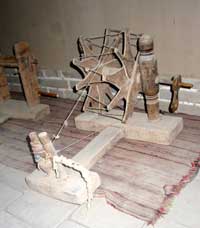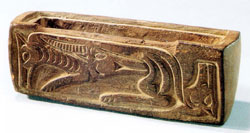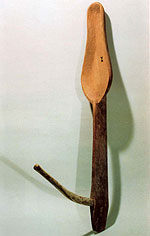|
FEATURES
Toghralek Villa | China Heritage Quarterly
TOGHRAKLEK VILLA:
AN OASIS AMONG CHINA'S MUSEUMS

Fig. 1 Plaque of Toghraklek Villa, Qiemo. [BGD]
Qiemo (Uyghur: Cherchen) is an oasis town poised on the Southern Silk Road at the south-western corner of the Taklimakan Desert. The town has a long history and has managed to preserve much of its oasis character. At a distance of 40km into the desert are the ruins of the ancient city of Qiemo, centre of the kingdom of Jumo mentioned in Han shu, the dynastic history of the Han.

Fig. 2 Spinning wheel in folkloric collection in Toghraklek Villa, Qiemo. [BGD]
Qiemo is also home to a little visited, but delightful, museum, located in what was once one of the homes of Niyaz Beg, the first xianzhang or county leader of Qiemo, reserved for his third wife. The house, called Toghraklek Villa (Chn.: Tuohulake zhuangyuan), was built around 1911, and is a beautifully preserved and restored example of Kashgar-style aristocratic architecture. Niyaz Beg was a powerful local leader, but he was executed by the KMT warlord of Xinjiang, Sheng Shicai, in 1936. The house remained the property of Niyaz Beg's family until 1958 when it was requisitioned to become the headquarters of the local commune's production brigade. Later it housed a school and the offices of the local Communist Party. This probably contributed to the excellent state of preservation of the house today.

Fig. 3 General view of entrance hall of Toghraklek Villa, Qiemo. [BGD]

Fig. 4 Ceiling skylights ( dereze) in ablutions room of Toghraklek Villa, Qiemo. [BGD]

Fig. 5 Wall decorated with recessed niches (Uyghur: oyuq) in the men's parlour in Toghraklek Villa, Qiemo. [BGD]
In 1998, the house was converted into a museum of local folklore. (See Fig. 1) Two teachers and 20 students from Xinjiang University, on a field assignment for the university's museum in 1995, collected approximately 500 antiquated and often discarded items of daily use from houses and farms in the Qiemo area. Some of the objects were donated, and a few were purchased for the museum. The collection of folkloric material was divided between Xinjiang University Museum and this small museum in Qiemo, then still in its planning stage. The brick house is constructed on a raised platform, and one ascends several steps to enter the colonnaded courtyard. Here many of the larger farm implements and other items from the folkloric collection are laid out for visitors. An oil press, a traditional timber cradle, a cotton carding bowl and carding bow, bronze urns, wooden plates, ploughs and water buckets are arranged on the surrounding veranda for visitors to see. The objects include impressive saddles, both for donkeys and horses, as well as a spinning wheel (see Fig. 2). Most of these objects would probably be little different from those used for centuries.

Fig. 6 (left)Turdi Kerim, director of Cultural Relics Office in Qiemo, and (right) Ismael Ependi, translator, in men's parlour of Toghraklek Villa, Qiemo. [BGD]

Fig. 7 Woollen twill fabric with animal pattern unearthed from grave no. 34 at the Zaghanluq cemetery and the property of Toghraklek Villa, Qiemo.

Fig. 8 Timber box with wolf and sheep pattern unearthed from grave no. 64 at the Zaghanluq cemetery and now displayed in Toghraklek Villa, Qiemo.

Fig. 9 Timber musical instrument called konghou unearthed from grave no. 14 at the Zaghanluq cemetery and now displayed in replica form at the Toghraklek Villa, Qiemo.
Entering the building itself, one is ushered into a large rectangular area surrounded by raised platforms which simultaneously served as the reception hall for guests and travellers, as well as a performance area where guests could be entertained by musicians. (See Fig. 3) The brick and mortar are as firm as when originally laid nearly a century ago. Large timber columns support the roofing around this open court.
From the entrance court one proceeds into the residential section of the house. The cool adobe floors, which are completely covered with carpets, are flush with the elegantly ornamented plastered walls. The use of plaster mixed with egg whites to finish the inner walls has resulted in a surface with a dazzling white smoothness rarely seen today. The ceilings and the beams of the room are elaborately carved timbers, and the decorative motifs vary on each ceiling beam. Some of the rooms, such as the master bedroom, the changing room and the ablutions room, feature discreet skylight windows (see Fig. 4), but there are no windows in the outer walls.

Fig. 10 "Cherchen Man" unearthed in 1985 from grave no. 2 at the Zaghanluq cemetery and now in the collection of the Xinjiang Regional Museum.
The house consists of 13 large rooms, including a storeroom, two bedrooms, a prayer room, two parlours (one for men and one for women) and the large audience hall. The decoration is particularly ornate in the parlours and the prayer room. The walls of the men's parlour are highly decorated with geometric and non-iconic fretwork. There are large and small recessed niches in the walls and spaces were stoves and samovars were once set. (See Fig. 5) Carpets, clothes of the period, bolsters and bedding convey a sense of the luxury that once attended life in this mansion. Cabinets and sideboards made of mulberry timber complement the simplicity of the building's design.

Fig. 11 Outer view of entrance of Zaghanluq Cemetery Site Museum, Qiemo. [BGD]
The chief curator of the museum, Turdi Kerim (see Fig. 6), is also the director of the local Cultural Relics Office, and so it is no surprise that one room of the mansion now houses a small collection of antiquities unearthed at the renowned Zaghanluq cemetery nearby. On display are woollen textiles produced by the "Caucasian" inhabitants of this oasis at a time contemporary with the Warring States period in the Central Plains which suggest striped and "tartan" patterns that could have been produced in England even thirty years ago. Some of the textiles were dated by the archaeologist Wang Bo and these yielded a date more than 2,000 years BP. The museum also houses a number of renowned objects from the Zaghanluq site, including a sample of woollen twill fabric with animal pattern unearthed from grave no. 34 at the cemetery. (See Fig. 7) Other artefacts from the Zaghanluq site include gold ornaments, ladles made from horse bone, and wooden plaques with hieroglyphic symbols that were worn to indicate rank. Other well known objects that can be seen in the museum are a timber box with an illustration of a wolf and a sheep that was unearthed from grave no. 64 (see Fig. 8), and a timber musical instrument, called a konghou, resembling an Egyptian lyre without its strings, unearthed from grave no. 4. (See Fig. 9) The vast quantity of material from the Zaghanluq cemetery, including the renowned mummies such as Cherchen Man (see Fig. 10), are now to be found in the collection of the Xinjiang Museum, although they are loaned at times to other major museums throughout China.
The Zaghanluq cemetery itself is located in the desert only 15 minutes' drive from the Villa, and it was here that these spectacular finds were made in the course of four major excavations since 1985, some of the most noteworthy material being uncovered in the excavations of 1985 and 1996. Visiting the Zaghanluq Site Museum (see Fig. 11) is extremely rewarding, because here one can see grave no. 24, a large pit grave once covered with timbers that houses 24 members of a single family. It is startling to realise that there has been little change in the line of vegetation demarcating the Qiemo oasis from the Taklimakan desert in over two millennia. [BGD]
|